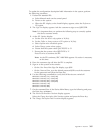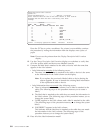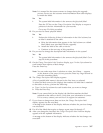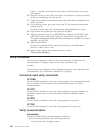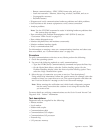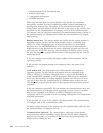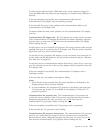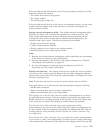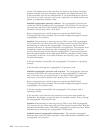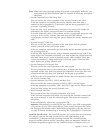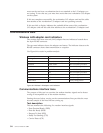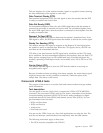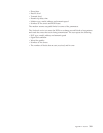
If the test completes successfully, memory modules on the I/O processor card are
operational.
If the test fails, a memory module on the I/O processor card is failing. If the
memory modules on the card are replaceable, exchange the failing memory
module. Otherwise, exchange the communications I/O processor card.
Communications Port A modem and coupler test: The communications port A
modem and coupler test verifies that the modem (which is built into the I/O
adapter card) and the externally attached coupler are operating correctly. The
coupler is attached to the port of the I/O adapter card. Because this test loads a
diagnostic program into the card, you must vary off all lines from the
communications I/O adapter before running this test.
If these tests complete successfully, the modem and the coupler are operational.
If a modem error appears on the Results display, exchange the I/O adapter.
Note: A test is provided for both ports (A and B) on the I/O adapter card. If one
port is operational, the I/O adapter card is still operational.
If a coupler error appears on the Results display, exchange the coupler.
External ring test:
Note: The External Ring Test is not supported on token-ring hardware for V4R5.
The External Ring test verifies that all hardware to the network is operational. It is
available for token-ring networks and distributed data interfaces. To run this test,
all hardware must be connected as it would be in normal operation. This test
allows a signal to be sent through the network and wrapped (no wrap connectors
are required).
If the test completes successfully, the adapter, cable, and access unit are operating
correctly.
For further problem analysis if the test fails, run the cable and I/O adapter tests in
the order in which the display lists them.
Communications/Local Area Network (LAN) link test: The
communications/local area network link test allows you to send data to remote
equipment using the Ethernet, token-ring, DDI, wireless, SDLC, X.25, or BSC
protocols. This test is useful on multipoint lines to verify that a specific terminal is
operating correctly without interrupting normal operation of the other terminals.
To run this test, you must have the line varied on, and you must make a
connection with the remote equipment. This is necessary because the functional
communications program performs this test. If you are using the BSC protocol and
the remote equipment is not an iSeries server, a service representative is needed at
the remote location to start diagnostic programs. When you run a link test against
the Local Area Network, you can enter *NONE in the controller description field to
test a specific remote adapter address.
If this test completes successfully, all equipment within the communications link is
operating correctly.
312 Service Functions V5R2




